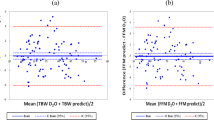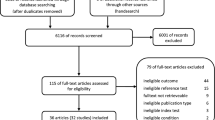Abstract
OBJECTIVE: To estimate the reliability of anthropometric measurements in overweight and lean subjects, and to examine the influence of this reliability on correlations to other variables, since low reliability leads to underestimation of correlations.
DESIGN: Replicate measurements by two observers in 26 overweight and 25 lean subjects measured at two occasions.
MEASUREMENTS: Sagittal abdominal diameter (SAD), waist circumference (waist), waist-to-hip ratio (W/H) and skinfold measurements.
RESULTS: Intra-class correlation coefficients (ICCs) for SAD and waist were higher than for W/H (0.98 vs 0.90, P<0.001, and 0.97 vs 0.90, P=0.001, respectively). For waist, the ICC was lower for overweight than for lean subjects (0.85 vs 0.95, P=0.030), but the ICC values were comparable for SAD and W/H (0.92 vs 0.95 and 0.78 vs 0.83, respectively). Intra-observer variations (IOV) for SAD and waist were lower than for W/H (coefficients of variation; 1.6%, 1.4% and 2.3%, respectively), as were intra-subject variations (ISV) (2.7%, 3.0% and 3.4%, respectively). ICC values ranged from 0.84 to 0.93 and were lower for overweight than for lean subjects for biceps, subscapular and umbilical skinfolds (P=0.031, P<0.001 and P=0.048, respectively). Coefficients of variations for skinfold measurements ranged between 7.3% and 16.0% for IOV and between 14.9% and 20.8% for ISV.
CONCLUSIONS: The low ICC values imply that correlations can be underestimated in overweight groups. We propose that, because of their higher reliability, SAD and waist have a higher predictive capacity for cardiovascular risk than W/H. SAD is the only measurement with high reliability in both weight groups and its use is recommended.
This is a preview of subscription content, access via your institution
Access options
Subscribe to this journal
Receive 12 print issues and online access
$259.00 per year
only $21.58 per issue
Buy this article
- Purchase on Springer Link
- Instant access to full article PDF
Prices may be subject to local taxes which are calculated during checkout
Similar content being viewed by others
References
Larsson B, Svärdsudd K, Welin L, Wilhelmsen L, Björntorp P, Tibblin G . Abdominal adipose tissue distribution, obesity, and risk of cardiovascular disease and death: 13 year follow up of participants in the study of men born in 1913 Br Med J 1984 288: 1401–1404.
Lapidus L, Bengtsson C, Larsson B, Pennert K, Rybo E, Sjöström L . Distribution of adipose tissue and risk of cardiovascular disease and death: a 12 year follow up of participants in the population study of women in Gothenburg, Sweden. Br Med J 1984 289: 1257–1261.
Ohlson LO, Larsson B, Svärdudd K, Welin L, Eriksson H, Wilhelmsen L, Björntorp P, Tibblin G . The influence of body fat distribution on the incidence of diabetes mellitus. 13.5 years of follow-up of the participants in the study of men born in 1913 Diabetes 1985 34: 1055–1058.
van der Kooy K, Seidell JC . Techniques for the measurement of visceral fat: a practical guide Int J Obes 1993 17:: 187–196.
Heymsfield SB, Tighe A, Wang ZM . Nutritional assessment by anthropometric and biochemical methods. In: Shils ME, Olson JA, Shike M (eds) Modern nutrition in health and disease, 8th edn Lea & Febiger: Malvern 1994, pp 812–841.
Lean MEJ, Han TS, Seidell JC . Impairment of health and quality of life in people with large waist circumference Lancet 1998 351: 853–856.
Pouliot MC, Despres JP, Lemieux S, Moorjani S, Bouchard C, Tremblay A, Nadeau A, Lupien PJ . Waist circumference and abdominal sagittal diameter: best simple anthropometric indexes of abdominal and visceral adipose tissue accumulation and related cardiovascular risk in men and women Am J Cardiol 1994 73: 460–468.
Richelsen B, Pedersen SB . Associations between different anthropometric measurements of fatness and metabolic risk parameters in non-overweight, healthy, middle-aged men Int J Obes 1995 19: 169–174.
Han TS, van Leer EM, Seidell JC, Lean MEJ . Waist circumference action levels in the identification of cardiovascular risk factors: prevalence study in a random sample Br Med J 1995 311: 1401–1405.
Ashwell M, Cole TJ, Dixon AK . Ratio of waist circumference to height is strong predictor of intra-abdominal fat Br Med J 1996 313: 559–560 (letter).
Öhrvall M, Berglund L, Vessby B . Sagittal abdominal diameter compared with other anthropometric measurements in relation to cardiovascular risk Int J Obes 2000 24: 497–501.
Durnin JVGA, Womersley J . Body fat assessed from total body density and its estimation from skinfold thickness: measurements on 481 men and women aged from 16 to 72 years Br J Nutr 1974 32: 77–97.
Rosner B, Willett WC . Interval estimates for correlation coefficients corrected for within-person variation: implications for study design and hypothesis testing Am J Epidemiol 1988 127: 377–386.
Bland M . Clinical measurement. In An introduction to medical statistics. Oxford University Press: Oxford 1987, pp 276–278.
Kumlin L, Dimberg L, Mårin P . Ratio of abdominal sagittal diameter to height is strong indicator of coronary risk Br Med J 1997 314: 830 (letter).
Han TS, Richmond P, Avenell A, Lean MEJ . Waist circumference reduction and cardiovascular benefits during weight loss in women Int J Obes 1997 21: 127–134.
Allison DB, Paultre F, Goran MI, Poehlman ET, Heymsfield SB . Statistical considerations regarding the use of ratios to adjust data Int J Obes 1995 19: 644–652.
Hojby-Rasmussen M, Andersen T, Breum L, Hilsted J, Gotzsche PC . Observer variation in measurements of waist-hip ratio and the abdominal sagittal diameter Int J Obes 1993 17: 323–327.
Sonnenschein EG, Kim MY, Pasternack BS, Toniolo PG . Sources of variability in waist and hip measurements in middle-aged women Am J Epidemiol 1993 138: 301–309.
Ferrario M, Carpenter MA, Chambless LE . Reliability of body fat distribution measurements. The ARIC study baseline cohort results. Atherosclerosis risk in communities study Int J Obes 1995 19: 449–457.
Sullivan DH, Patch Ga, Baden AL, Lipschitz DA . An approach to assessing the reliability of anthropometrics in elderly patients J Am Geriatr Soc 1989 37: 607–613.
Author information
Authors and Affiliations
Corresponding author
Rights and permissions
About this article
Cite this article
Nordhamn, K., Södergren, E., Olsson, E. et al. Reliability of anthropometric measurements in overweight and lean subjects: consequences for correlations between anthropometric and other variables. Int J Obes 24, 652–657 (2000). https://doi.org/10.1038/sj.ijo.0801216
Received:
Revised:
Accepted:
Published:
Issue Date:
DOI: https://doi.org/10.1038/sj.ijo.0801216
Keywords
This article is cited by
-
3D Optical Imaging as a New Tool for the Objective Evaluation of Body Shape Changes After Bariatric Surgery
Obesity Surgery (2020)
-
Revisiting the United States Army body composition standards: a receiver operating characteristic analysis
International Journal of Obesity (2019)
-
A machine learning approach relating 3D body scans to body composition in humans
European Journal of Clinical Nutrition (2019)
-
High blood pressure and its relationship to adiposity in a school-aged population: body mass index vs waist circumference
Hypertension Research (2018)
-
Sagittal abdominal diameter and Framingham risk score in non-dialysis chronic kidney disease patients
International Urology and Nephrology (2018)



